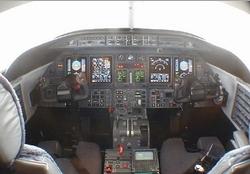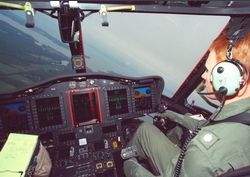Sure, Pilots Hate 'Em, But Some Think They're Vital
by ANN Contributor Steven R. Lund
 Sure, the FAA wants better audio
recording capabilities on cockpit voice recorders -- a move the
agency says would bring the aviation industry more in line with
current documentation technology. But what about video?
Sure, the FAA wants better audio
recording capabilities on cockpit voice recorders -- a move the
agency says would bring the aviation industry more in line with
current documentation technology. But what about video?
In July 2004 the US National Transportation Safety Board
conducted a formal hearing to scrutinize the feasibility, potential
benefits and drawbacks of requiring crash-protected cockpit imaging
systems, also called video recorders.
Over the course of the hearing's two days the NTSB heard
testimony from regulators, manufacturers, investigators, and pilots
to synergistically consider the issue from various points of view.
Some pertinent subjects examined at this hearing included the
following:
- The applicability of technologies like data encryption and how
this technology may be used to protect and secure images (and
other) data the technical feasibility and cost associated with
capturing, storing, and analyzing image data obtained from
commercial aircraft cockpits
- The potential accident investigation benefits of cockpit image
recorders (CIRs)
- The legal and privacy concerns of flight crews, air carriers,
regulatory agencies and international organizations
- The regulatory difficulties surrounding implementation of image
recorders
The applicability of technologies to record pertinent images has
been thoroughly examined over the last five years. The Safety
Board has conducted several symposia where individuals from
industry, unions, and government made presentations pertaining to
the issues of cockpit image recorders. One of these, was in May
1999-The International Symposium on Transportation Recorders, which
was cosponsored by the Safety Board and the International
Transportation Safety Association. This symposium prompted the FAA
to form a committee composed of industry, labor, and government
experts to examine emerging flight data recorder technology,
including cockpit image recording devices.
Witnesses testified at last year's hearing that a video
recording would have helped solve the small plane crashes that
killed Sen. Paul Wellstone of Minnesota in October 2002 and members
of the Oklahoma State University basketball team in January
2001.
The potential benefits of Cockpit Image Recorders to accident
investigation was conclusively proven during the rejected takeoff
accident investigation involving an Overseas National Airways (ONA)
wide body aircraft that went off the wet runway at New York's JFK
airport in November 1975. Case in point:

- The plane ingested numerous large seagulls into the right wing
engine just before takeoff prompting the pilot to initiate an abort
in an unsuccessful attempt to stop his high takeoff gross weight
airplane on the wet runway. The RTO was not successful because of
several factors:
- The engine caught fire, began breaking up and depositing hot
debris onto the runway directly in the path of the main landing
gear tires
- At least two, possibly three, of the four main landing gear
tires failed, severely impeding the braking on the right main
gear
- The hydraulic line to the brakes was severed on this damaged
gear, virtually eliminating any braking ability on that gear and
depleting that hydraulic system of its fluid
- the lack of braking ability and the asymmetry caused by the
uneven braking, asymmetric reverse thrust and asymmetric ground
spoilers (due to loss of one of the three hydraulic systems
powering the spoilers) caused the aircraft to uncontrollably drift
off to the right and off the runway
- The damaged landing gear collapsed upon exiting the hard
surface, the fire spread to the engine pylon and wing and the
aircraft was destroyed
Fortunately, the passengers were trained flight crew members
being repositioned for a foreign operation and all escaped the
burning plane with no serious injuries.
Objective Use Of Cockpit Video In Accident Investigation
 The ONA accident proved the virtue
of cockpit video by the fortuitous fact that an off duty captain,
seated in a cockpit jump seat behind the pilot in command was using
a hand held movie camera mostly trained on the instrument panel
with the throttle quadrant and pedestal in the foreground during
the takeoff roll and up until the plane exited the hard
surface.
The ONA accident proved the virtue
of cockpit video by the fortuitous fact that an off duty captain,
seated in a cockpit jump seat behind the pilot in command was using
a hand held movie camera mostly trained on the instrument panel
with the throttle quadrant and pedestal in the foreground during
the takeoff roll and up until the plane exited the hard
surface.
Despite the fact that the camera was hand-held, hence not fixed
to any particular constant field of view, investigators were still
able to do a frame by frame analysis revealing simultaneous events
to objectively correlate the cockpit situation with data provided
by CVR and DFDR information, clearly showing the entire sequence of
events leading to the accident, including:
The rapid pilot reaction time when the "ENG. FAIL" light
illuminated as the seagulls severely damaged the engine fan
section.
The airspeed indicator the pilot would be monitoring showing the
speed at which a safe abort should have been possible when the
birds hit the fan.
The comprehensive, objective information from the cockpit images
were then correlated with the sounds on the Cockpit Voice Recorder
(CVR) and all the data on the Digital Flight Data Recorder (DFDR)
with its very accurate time information.
An accurate assessment of the pilot reaction time compared to
FAA certification standards for pilot reactions for the anticipated
case of an engine failure on takeoff, which was designed to ensure
a safe stop within the stopping distance demonstrated to the FAA
during the certification process for all commercial aircraft
This objective cockpit image data also substantiates the
statement made by the witness at the NTSB hearing from the British
Aircraft Accident Investigation Branch [AAIB], the NTSB's
counterpart in the UK, who testified "that there might be gaps left
between the DFDR and CVR data." The dialogue recorded on the CVR
between the pilots "often leaves much to be desired."
"It's common to hear on CVR recordings 'Look at this' and we sit
there wondering what 'this' is," the head of the AAIB testified at
the hearing.
Investigators have been frustrated following numerous
investigations where Cockpit Voice recordings were totally lost
because of the Bulk ERASE feature designed into the current systems
ostensibly to protect Pilots' privacy-a system that provides a
button in the cockpit that will electrically degauss the entire CVR
tape when pushed. This system was sometimes activated by electrical
transients during the crash, rendering the tape useless.
The highly accurate, objective sequence of events the
investigators were able to document on the ONA accident coupled
with other high energy RTO accident investigations compelled the
industry to completely reconsider the RTO maneuver. From the FAA
Certification criteria of empirical stopping distance
determination, theoretical calculation using a standard set of
pilot reaction times, and aircraft hardware changes providing
additional information to the flight crews, including:
- Display all the M.L.G. tire/wheel temperatures and
pressures
- Adding a tire failure aural warning to enable pilots to
distinguish a tire failure from the "bang!" associated with a
failure of an engine
- Adding a system that would automatically apply the required
braking for a given situation, including the RTO mode, changing the
brakes from steel to a higher energy absorbing carbon material
- An improved anti-skid system under digital control with self
testing capability before every takeoff.
 The FAA changed the certification
test standards to require high energy takeoff acceleration then
deceleration to a full-stop to convincingly demonstrate an RTO can
be safely performed within the allotted stopping distance for each
airplane. This certification substantiation was previously made
during a landing roll by applying full anti skid braking when the
plane had decelerated to the calculated speed for the weight being
tested to simulated a high takeoff weight rejected takeoff using
brand new tires and cold brakes. While this test showed that the
brakes could absorb the requisite energy for the weight being
tested, it apparently did not realistic represent the actual RTO
condition in service where:
The FAA changed the certification
test standards to require high energy takeoff acceleration then
deceleration to a full-stop to convincingly demonstrate an RTO can
be safely performed within the allotted stopping distance for each
airplane. This certification substantiation was previously made
during a landing roll by applying full anti skid braking when the
plane had decelerated to the calculated speed for the weight being
tested to simulated a high takeoff weight rejected takeoff using
brand new tires and cold brakes. While this test showed that the
brakes could absorb the requisite energy for the weight being
tested, it apparently did not realistic represent the actual RTO
condition in service where:
- The airplane was accelerating during takeoff rather than
decelerating when the brakes are first applied
- Aircraft in-service virtually never operated with new tires and
brakes
- the brakes on the in-service airliners might have some residual
heat from being applied during taxi
- the takeoff might be rejected due to a tire failure, hence
severely limiting stopping capability.
These facts became evident following the investigation of
several high energy RTO accident investigations, firmly reinforced
by the cockpit images recorded during the ONA accident, then were
substantiated by follow-up simulator exercises and taxi tests on
actual aircraft. In the absence of Cockpit Image information,
investigators concluded that the most probable cause of the failure
of the aircraft to stop on the runway was the pilot failure to
react in a timely manner. But, the ONA cockpit images firmly proved
this was NOT the case. Hence, the further industry studies
producing radical changes in the national aviation system to
prevent further RTO accidents.
The manufacturer of the plane involved in the ONA, and other RTO
accidents, invited commercial pilots to participate in a simulator
training exercise designed to measure flight crew responses during
takeoff with simulated failures programmed to mimic those
experienced in actual RTO accidents. The engineering simulator used
was instrumented to record the same parameters as those recorded on
the DFDR, plus the cockpit environment was recorded by video during
each simulated run. The results of these similar tests showed some
surprising results:
The pilot's-in-command tended to reduce the full braking effort
once the plane's speed slowed, resulting in a simulated runway
overrun as in some accident cases.

Some pilots logically thought that what the FAA had
euphemistically dubbed "the takeoff decision speed" or V1 speed was
the highest speed they would allow before beginning to stop during
a rejected takeoff, when the actual case of making the decision AND
accomplishing all necessary actions to stop the plane before
reaching the V1 speed is the case, because of the manner in which
the stopping distance was predicated during certification: of
landing the plane beginning the stop with the aerodynamic drag
inducing ground spoilers deployed and waiting for the testing V1
speed then applying full brakes to bring the test plane to a full
stop in the measured distance.
Those pilots who waited until reaching the V1 speed before
deciding to initiate the aborted takeoff in the simulator after a
simulated failure prompting an abort, invariably went off the
simulated runway at a speed directly proportional to the speed
above the V1 speed the abort was initiated.
Theoretical calculations and these simulator tests showed that
if pilots attempted an aborted takeoff above the V1 speed, the
question became, how fast the plane would be going when it went off
the end of the runway, rather than if it would stop on the
runway.
The tests conducted in an actual airplane with instrumented tire
pressure and temperatures during taxi showed that excessive taxi
speeds and distances tended to heat the wheels, tires, and brakes
to unacceptable levels that would not permit a safe stop in the
event of a high energy RTO after the taxi.
When considering the unprecedented flight safety enhancements
made to the national aviation system (NAS) stemming from the direct
result of only one accident investigation using the objective
information investigators obtained from one isolated, hand-held,
cockpit image recorder. This leads one to wonder what the vast
impact would be to improving aviation safety overall should Cockpit
Image Recorders be required in all airplanes to be used in the
investigation of aviation mishaps.
In 2000 the Board addressed the larger category aircraft.
Recommendation A-00-30 asked the FAA to require the retrofit of
existing aircraft operated under 14 CFR Parts 121, 125, or 135, and
currently required to be equipped with a CVR and digital flight
data recorder (DFDR) with a crash-protected image recorder system.
Safety Recommendation A-00-31 was identical, except it covered
newly manufactured aircraft.
Cockpit Video Recordings For Flight Crew Training
In addition to aiding investigators in objectively determining
the most probable cause of accidents and incidents, CIRs have, and
will continue to, act as a valuable flight training aid to greatly
enhance future flight safety. For instance, the images from the ONA
RTO at JFK were used to make an RTO training Video currently being
used by airlines world wide. After the aircraft manufacturer of the
plane involved in the ONA accident produced the training video and
distributed it free of charge to several customer airlines
throughout the world, one foreign airline was given the video
script to reproduce the video with foreign subtitles. In addition,
another manufacturer of large jetliners also produced a similar
training video.
A valuable tool in the simulator training in Cockpit Resource
Management by a leading US Airline was a cockpit video recording of
flight crew responses to simulated emergencies, which was later
analyzed by the crew in training to realistically show their
performance. This very successful training program was initiated
with the proviso that the video recordings would be destroyed
immediately following completion of the training.

Legal Issues
To protect the privacy of pilots, CIRs in actual airline
operation, would be covered by the same law that currently protects
Cockpit Voice Recordings, but the law would have to be strengthened
to include foreign operations as indicated by the words of the
Airline Pilots Association's (ALPA) executive safety committee
chairman, who expressed serious concerns about keeping recordings
from the media once the plane enters international airspace,
pointing to the voice recording from an American Airlines jet that
crashed in Colombia in 1995: "parts of that tape were broadcast by
NBC," said the ALPA spokesman.
But, surely when legislators weigh the life-saving benefits CIRs
provide against the pilot privacy issues, stern international
statutes will be enacted to protect pilots from improper public
disclosures of CIR information, to be used in litigation. For
example, just as NTSB reports currently are not admissible in court
under US law, and as the existing International Civil Aviation
Organization (ICAO) rules stipulate. So, when the CIR information
is used for accident investigation only and is kept strictly
confidential, there will be no question about the life-saving
benefits Cockpit video will provide aircraft accident investigators
in their task of preventing future accidents.
Attempts to mandate such a valuable asset for accident
investigators would naturally be resisted by the pilots and their
Airline employers because such counterproductive, unauthorized use
of CIR by the media would prompt Plaintiff's Attorneys to undertake
frivolous legal action against the pilots in the recording because
of ignorance and misinterpretation of the cockpit situation. So,
unauthorized public release of this recorded information must be
strictly prohibited by international Laws before any Cockpit
recordings (Video or Voice) can be used effectively to radically
improve future Flight Safety.
(Steve Lund is the retired
Director of Flight Safety Investigations from Douglas
Aircraft Co. -- now Boeing -- in Long Beach, CA)
 ANN's Daily Aero-Linx (04.16.24)
ANN's Daily Aero-Linx (04.16.24) Aero-News: Quote of the Day (04.16.24)
Aero-News: Quote of the Day (04.16.24) Airborne 04.10.24: SnF24!, A50 Heritage Reveal, HeliCycle!, Montaer MC-01
Airborne 04.10.24: SnF24!, A50 Heritage Reveal, HeliCycle!, Montaer MC-01 Airborne 04.12.24: SnF24!, G100UL Is Here, Holy Micro, Plane Tags
Airborne 04.12.24: SnF24!, G100UL Is Here, Holy Micro, Plane Tags Airborne-Flight Training 04.17.24: Feds Need Controllers, Spirit Delay, Redbird
Airborne-Flight Training 04.17.24: Feds Need Controllers, Spirit Delay, Redbird








